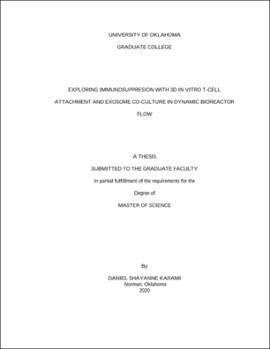| dc.description.abstract | Cancer is a prevalent disease that impacts many lives all over the world, projected to pass more than 27 million deaths in 2030. Among many cancer therapies and treatment solutions are immunotherapies, which can include pharmaceuticals and genetic solutions like Car-T; however, the innate and reactivated immune responses are silenced. 10-100 nm diameter known as exosomes are produced by every cell in the body and found in almost every bodily fluid, and this is also true of cancerous cells and tumors as well. These exosomes not only mimic the parental cell’s membrane through their exit process, but also are loaded with bioactive molecules like RNA that interact with neighboring cell population and even downstream cells and environments. T-cells are responsible for many of the cytotoxic responses in the body, but due to hypothesized immunosuppressive properties of cancerous exosomes and tumor microenvironments, are inevitably silenced. As the literature and field of study of exosomes are in their infancy, inconsistencies are prevalent studies due to complexity of the nanoscale nature and complex tumor environments, especially in vivo models. 3D environments impact almost every cell interaction and physical characteristic in cell environments and culture. Alongside the infancy of engineering and 3D macroscale in the oncological field, there exists the same dynamic for exosomal studies. Our 3D flow perfusion system poses solutions and a unique platform to combine the components present in an in vivo environment for not only T-cells and exosomes, but also other cells and therapeutics. Surface modification can be used on 3D printed scaffolds to control for geometry and microenvironments using RGD as a binding motif for T-cells. Immobilized T-cells can be used to reduce suspension variability to measure the effects of exosomes on immune suppression. IL-2, a common proliferation cytokine, is released by T-cells when stimulated by PMA, and the response and activation of T-cells can be correlated to their cytokine production. When co-cultured with exosomes from H1299 and A549 cancer cell lines, T-cells showed decreased IL-2 concentrations when increasing the exosome culture ratios from a 1:10 ratio to 1:1000 ratio in 3D flow perfusion with rates of 0.15 mL/min. IL-2 production began, in 3D testing, around 4000±500 pg/mL to negligible absorbance responses compared to the IL-2 standards at 1:1000 T-cells to exosomes. Our system hinted towards the immunosuppressive properties of exosomes in 3D seen in 2D testing and can be further extended towards more complex environments in our 3D bioreactor flow perfusion system. | en_US |
